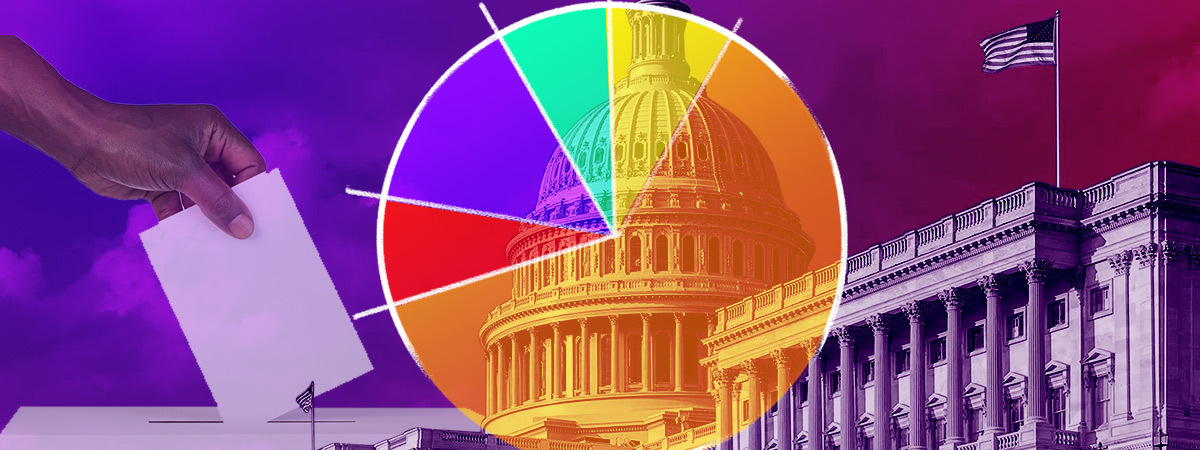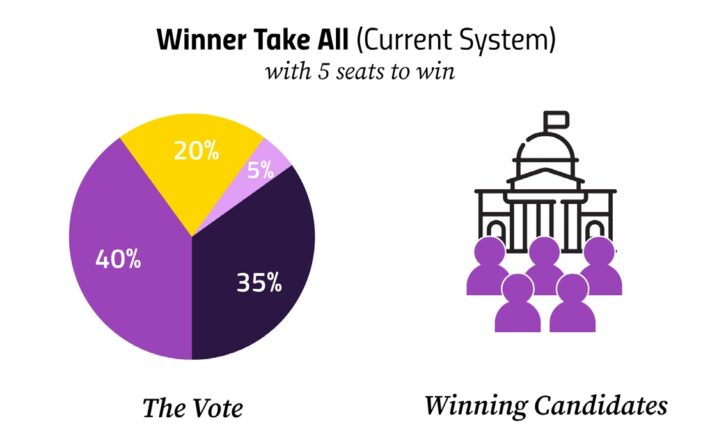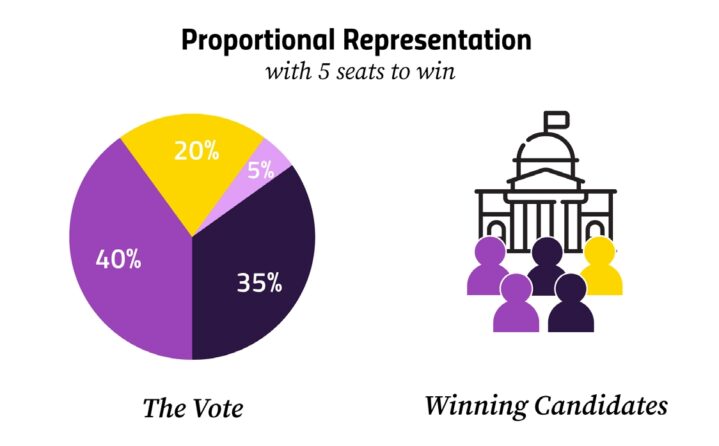
 |
By Dave O'Brien Policy Director |
September 10, 2024
What is proportional representation?
Proportional representation is a category of electoral systems where the vote share of a group of voters corresponds to the number of representatives that group elects. For example, under a proportional system, if a third of the voters vote for a party’s candidates for legislature, that party would win about a third of the seats up for election.
On the other hand, a winner-take-all system is a category of electoral systems where the single biggest group of voters can win all of the representation. There are many different winner-take-all electoral systems, but any election that elects a single candidate, like an election for a representative from a single-member district, will always be a winner-take-all election. For some kinds of office, like mayor or governor, where there is only one person who can serve at a time, a winner-take-all system is unavoidable. Elections for bodies where more than one person serve at a time, like Congress or school boards, can use either winner-take-all or proportional systems.
How does it differ from our current winner-take-all system?
Most American elections use winner-take-all voting systems. Proportional representation differs from winner-take-all systems in several key ways:
How Seats are Won: In a winner-take-all system, the candidate (or group of candidates in elections to fill multiple at-large seats at once) who receives the most votes in each electoral district wins all of the seats up for election. This often leads to a situation where a candidate can win the election with less than 50% of the vote if there are multiple candidates running. In contrast, in a proportional representation system, seats in the legislature or governing body are allocated proportionally based on the total votes received by each party or candidate.


Representation of Minority Views: Winner-take-all systems tend to favor larger political parties because they can win seats even with a plurality of votes while third parties who win a big chunk of votes but don’t end up beating every other party would get nothing. This can marginalize smaller parties and minority viewpoints, leading to a less diverse representation in the legislature. Proportional representation systems, on the other hand, provide more opportunities for smaller parties or any other group that votes together (racial, ethnic, geographic, economic, etc.) to win seats and ensure that a broader range of political views is represented.
Wasted Votes: In winner-take-all systems, votes cast for losing candidates or for candidates who win by large margins are essentially wasted, as they do not contribute to the election of representatives. In states that are gerrymandered, a vote cast by a voter in the non-dominant party is meaningless as the makeup of the voting district likely ensures a predetermined outcome. On the flipside, a vote cast by a voter in the dominant party is meaningless because whether their candidate gets 60% of the vote or 90% of the vote, the outcome is the same. Proportional representation systems typically have fewer wasted votes because seats are allocated based on the overall proportion of votes received by each party or candidate, meaning that even votes for losing parties can contribute to the allocation of seats.
While winner-take-all systems prioritize simplicity, proportional representation systems prioritize fairness, diversity of representation, and accuracy in reflecting the electorate's preferences.
How would proportional representation be good for the US?
In an era when a record number of Americans don’t identify with either of the two major political parties, proportional representation could open the door to more political parties and more options for voters that feel more closely aligned with their values.
Advantages of a proportional representation
Fairness and Representation: proportional representation systems aim to ensure that the distribution of seats in the legislature reflects the proportion of votes received by each political party or group. This leads to a more accurate representation of the diverse political viewpoints within the electorate.
Reduced Wasted Votes & Combat Gerrymandering: proportional representation systems typically have fewer wasted votes compared to winner-take-all systems, where votes cast for losing candidates or for candidates who win by large margins do not contribute to the election outcome. In proportional representation systems, even votes for losing parties can contribute to the allocation of seats. Similarly, proportional representation systems are less susceptible to gerrymandering compared to winner-take-all systems because votes from the non-dominant political party in a district can still contribute to winning candidates.
Inclusivity: proportional representation systems provide opportunities for smaller parties and minority viewpoints to win representation in the legislature. This can lead to a more inclusive political landscape and ensure that a broader range of perspectives are considered in decision-making processes.
Stability and Consensus Building: proportional representation systems often result in coalition governments, where multiple parties must work together to form a governing majority. This can encourage collaboration and compromise among political parties, leading to more stable and inclusive governance.
Disadvantages of our current winner-take-all system
The winner-take-all electoral system that we use in the United States has several drawbacks:
Wasted Votes & Susceptibility to Gerrymandering: In winner-take-all systems, votes cast for losing candidates or for candidates who win by large margins are essentially wasted, as they do not contribute to the election of representatives. This is particularly true in states that are gerrymandered where, due to the strategic slicing of voting maps, the dominant party’s victory is all but certain. This can leave many voters underrepresented and lead to a sense of disenfranchisement among voters whose preferred candidates or parties do not win.
Disproportionate Representation: Winner-take-all systems can lead to disproportionate representation, where parties with a minority of the total votes can win a majority of seats or parties with a bare majority win a supermajority. This can result in governments that do not accurately reflect the overall preferences of the electorate.
Underrepresentation of Minority Views: Winner-take-all systems tend to favor larger political parties because they can win seats even with a plurality of votes. This can marginalize smaller parties and minority viewpoints, leading to a less diverse representation in the legislature.
Polarization and Divisiveness: Winner-take-all systems can contribute to political polarization and divisiveness by promoting a "winner-takes-all" mentality and discouraging cooperation and compromise among political parties.
Lower levels of trust in government: Under our current election system, the public’s trust in government has reached near record lows. In winner-take-all systems, a vote cast for a candidate can often be meaningless if they are in the minority of voters and voters can often find themselves represented by candidates who they didn’t vote for. Under a proportional representation system, voters tend to have more trust in their government because they're more likely to see people they support in office (even if they're not in the majority)
Overall, while winner-take-all systems have some advantages, such as simplicity and familiarity, they also have significant drawbacks that can undermine democratic principles and lead to outcomes that do not accurately reflect the will of the electorate. Electoral reforms proportional representation can address these shortcomings and create more representative and inclusive political systems.
What are the different types of proportional representation?
There are several types of proportional representation, each with its own nuances, but common to all of them is the idea that the overall composition of the legislative body reflects the distribution of votes in the electorate, providing a more accurate representation of diverse political opinions.
The specific details and mechanisms can vary from system to system. Here are a few of the more common types:
List systems are proportional representation methods that award seats to political parties or slates of candidates based on each party or slate's voteshare.
- In closed list systems, voters vote for a party or slate. The party or slate publicizes a list of its candidates in an order it decides ahead of the election. If the party wins three seats due to its overall voteshare, for example, then the first three candidates on the list will be elected.
(Example of a Closed List Ballot)
- In open list systems, voters vote for the individual candidates who are each identified with a particular party or slate and whose combined votes are used to determine the vote share of their party or slate. If the party wins three seats due to its overall voteshare, for example, then the three candidates of that party or slate who received the most votes will be elected.
(Example of an Open List Ballot)
Proportional ranked choice voting (proportional RCV), also known as “the single transferable vote,” is a form of ranked choice voting used to proportionally elect multiple candidates. Instead of electing the candidate who receives a majority of votes, proportional RCV elects candidates using a threshold determined by the number of people who will be elected. An election to fill two seats requires each winning candidate to get more than a third of the votes to win, an election to fill three seats requires each candidate to win more than a fourth of the votes, and so on.
(Example of a Proportional RCV Ballot)
► RELATED: How to Get the Most Out of Multi-Winner RCV: A Policy Guide
Hybrid systems are voting methods that combine elements of winner-take-all methods and proportional methods that produce proportional results overall.
- Mixed-member proportional (MMP) is a hybrid system where some members of an elected body are elected on a winner-take-all basis from single-winner districts, and others are elected proportionally using a list system. This keeps the connection between representatives and geographic constituencies common to winner-take-all elections while still producing an elected body that proportionally reflects the electorate overall.
(Example of a Mixed-Member Proportional Ballot)
Semi-proportional methods are voting methods that can allow groups of voters to elect candidates in proportion to their vote share under certain conditions but do not necessarily guarantee a proportional outcome. Like proportional RCV, semi-proportional methods allow voters to vote for individual candidates and do not require candidates to run as part of a slate or party list. Most semi-proportional methods elect the individual candidates with the most votes (e.g., In an election to fill three seats, the three candidates who receive the most votes win). Types of semi-proportional methods include:
- Cumulative voting – A voting method that provides voters with as many votes as there are candidates to be elected and allows voters to give multiple votes to the same candidate. In an election to fill three seats, for example, a voter could vote for three different candidates, give one candidate two votes and another candidate one vote, or give three votes to the same candidate.
(Example of a Cumulative Voting Ballot)
- Limited voting – A voting method that allows voters to vote for fewer candidates than there are candidates to be elected. In an election to fill five seats, for example, a voter might be able to vote for up to three candidates.
(Example of a Limited Voting Ballot)
Where is proportional representation currently used in the US?
Though most American elections use winner-take-all voting methods, our country has a long history of democratic experimentation.
In the early 20th century, two dozen American cities adopted proportional Ranked Choice Voting, including major cities like New York, Cleveland, and Cincinnati. Illinois used cumulative voting, a semi-proportional voting method, to elect its House of Representatives for over a century, and Puerto Rico uses another semi-proportional method called the single non-transferable vote, which is a form of limited voting, to elect some seats in both chambers of its legislature.
Proportional representation is used to elect some local offices in places like Minneapolis, MN and Cambridge, MA, for decades, and voters in Portland, OR’s approval in 2022 of a ballot measure to adopt proportional RCV to elect its entire city council has sparked greater national interest in proportional methods.
Does a proportional representation system have a future in United States elections?
If we want to create a stronger, more robust and responsive government, we need to give reforms like proportional representation a serious look as it has potential to produce elected bodies that more closely match voter preferences, lead to more competitive elections with better outcomes, and reduce the impacts of gerrymandering.
Obstacles to proportional representation:
At the federal level: In 1967, Congress passed a law that bans House districts from electing more than one representative, which it would have to repeal before the House of Representatives could be elected using proportional representation.
- Solution: Congress could do this with a regular bill. Unlike some other big pro-democracy reforms, we don’t need to amend the US Constitution (a nearly impossible task) to elect the House of Representatives with proportional representation.
At the state level: Many state constitutions effectively require winner-take-all elections for the legislature through requirements that each legislator be elected in a single-member district.
- Solution: Many local government election methods can usually be changed by the local governments themselves or by an ordinary bill in the state legislature. And amending a state’s constitution is a much easier prospect than amending the U.S. Constitution thanks to citizen-led direct democracy options like the ballot initiative process which has been used successfully throughout history to enact change when elected officials fail to act.
Seeing momentum:
- In our 2023 States of Reform project, we saw many bills that could bring proportional representation at the state and local levels that showed interest in forms of proportional representation and Portland, Oregon’s adoption of proportional RCV is a huge opening in the conversation.
- The Fair Representation Act, which RepresentUs supports, is a bill in Congress that would adopt proportional RCV for the U.S. House of Representatives.
Aim for perfect, push for good, get involved.
We can aim for implementing forms of proportional representation when opportunities arise, knowing full well a total move to proportional representation is a long term project.
In the meantime, there are a number of reforms that give voters better choices and better outcomes that are totally politically viable and achievable today.
Things like Ranked Choice Voting, Independent Redistricting Commissions to end partisan gerrymandering, and tough anti-corruption laws to restore trust in our government have proven popular with voters.
RepresentUs is leading the movement city by city, state by state to push for reforms that fix our broken political system. Are you with us?





